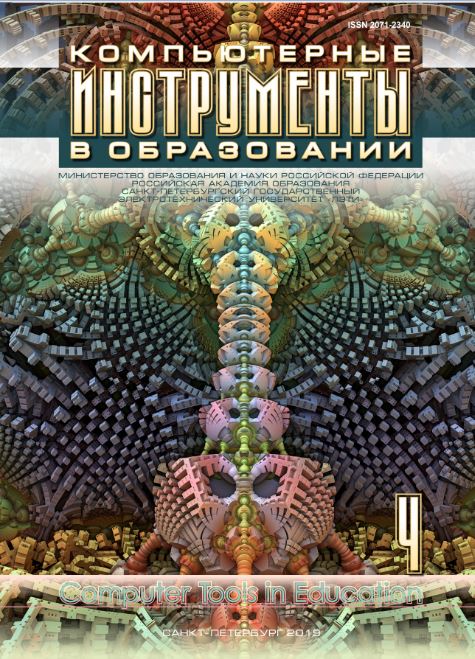Chemoinformatics: Applications of Computer Science in the Analysis of Chemical Structures (on the Example of Cadmium Sulfide)
Abstract
The article is aimed at demonstrating the practical application of graph theory as a subsection of the theoretical foundations of computer science in solving one of the interdisciplinary problems — describing the structure of the cadmium sulfide molecule using methods and indices of chemoinformatics. The article presents the results of calculations of the atom-bond connectivity index (ABC), of the geometric and arithmetic index GA, of the generalized Randic index, GA5 and ABC4, of the Zagreb indices for the
chemical graph of cadmium sulfide (CdS). Topological indices for cadmium sulfide are considered for the first time, although the task of calculating these indices is not new in itself. The relevance of the results is emphasized by the fact that cadmium sulfide is widely used in various fields, such as optoelectronics, photodetectors, photoresistors, etc.
References
W. Gao, A. Q. Baig , W. Khalid, and M. R. Farahani, “Molecular description of copper (II) oxide,” Macedonian Journal of Chemistry and Chemical Engineering, vol. 36, no. 1, pp. 93–99, 2017; doi: 10.20450/mjcce.2017.1138
A. Mohajeri, M. Alipour, and M. B. Ahmadi, “A graph theory study on (Z nS)n (n = 3-10) nanoclusters,” Chemical
Physics Letters, vol. 503, no. 1–3, pp. 162–166, 2011; doi: 10.1016/j.cplett.2010.12.067
A. A. Taherpour, “Quantitative structural relationship and theoretical study of electrochemical properties of C60@[SW C N(5, 5) − Ar mchai r −CnH20] complexes,” Chemical Physics Letters, vol. 469, no. 1–3, pp. 135–139, 2009; doi: 10.1016/j.cplett.2008.12.039
W. Gao, M. Imran, M. K. Siddiqui, M. Naeem, and F. Jamil, “Molecular description of copper (I) oxide and copper (II) oxide,” Quimica Nova, vol. 41, no. 8, pp. 874–879, 2018; doi: 10.21577/0100-4042.20170257
F. Deng, X. Zhang, M. Alaeiyan, A. Mehboob, and M. R. Farahani, “Topological Indices of the Pent-Heptagonal Nanosheets V C5C7 and HC5C7,” Advances in Materials Science and Engineering, 2019; doi: 0.1155/2019/9594549
International Agency for Research on Cancer, "Cadmium and cadmium compounds,"Monographs on evaluation of carcinogenic risks to humans, vol. 58, pp. 119-237, 1993.
K. L. Chopra and S. R. Das, Thin film solar cells, M. M. Koltun ed., Moscow.: Mir, 1986 (in Russian).
I. A. Petukhov, D. A. Zuev, A. V. Shorokhova, L. S. Parshina, O. A. Novodvorskii, O. D. Khramova, A. A. Lotin, F. N. Putilin, V. F. Kozlovskii, V. K. Ivanov, M. N. Rumyantseva, and A. M. Gaskov, “Cadmium sulphide thin films for photovoltaic applications,” Comp. nanotechnol., no. 1, pp. 68–73, 2014 (in Russian).
K. Paul, Handbook of Infrared Optical Materials, Boca Raton, FL, USA: CRC Press, 1991.
B. K. Mohammed, “Insight into the origin of magnetism in Iron-doped cadmium sulfide thin films from first principles calculations,” Solid State Communications, vol. 253, no. 10–13, 2017; doi: 10.1016/j.ssc.2017.01.021
M. Randi´c, “On characterization of molecular branching,” J. Amer. Chem. Soc., vol. 97, no. 23, pp. 6609–6615, 1975; doi: 10.1021/ja00856a001
D. Amic, D. Beslo, B. Luci´c, S. Nikoli´c, and N. Trinajsti´c “The vertex-connectivity index revisited,” J. Chem. Inf. Comput. Sci., vol. 38, no. 5, pp. 819-–822, 1998; doi: 10.1021/ci980039b
B. Bollobas and P. Erdos, “Graphs of extremal weights,” Ars Combinatoria, vol. 50, pp. 225-–233, 1998.
I. Gutman and K. C. Das, “The first Zagreb index 30 years after,” MATCH Commun. Math. Comput. Chem, vol. 50, pp. 83-92, 2004.
I. Gutman and N. Trinajsti´c, “Graph theory and molecular orbitals. Total φ-electron energy of alternant hydrocarbons,” Chemical Physics Letters, vol. 17, no. 4, pp. 535-–538, 1972; 10.1016/0009-2614(72)85099-1
E. Estrada, L. Torres, L. Rodriguez, and I. Gutman, “An at-om-bond connectivity index: Modeling the enthalpy of formation of alkanes,” Indian J. Chem., vol. 37A, no. 10, pp. 849-–855, 1998.
A. Ghorbani and M. A. Hosseinzadeh, “Computing ABC4 index of nanostar Dendrimers,” Optoelectronics and
Advanced Materials–Rapid Communications, vol. 4, pp. 1419-1422, 2010.
D. Vukicevi´c and B. Furtula, “Topological index based on the ratios of geometrical and arithmetical means of end-vertex degrees of edges,” J. Math. Chem., vol. 46, pp. 1369-–1376, 2009; doi: 10.1007/s10910-009-9520-x
A. Graovac, M. Ghorbani, and M. A. Hosseinzadeh, “Computing fifth geometric-arithmetic index for nanostar Dendrimers,” Journal of Mathematical Nanoscience, vol. 1, no. 1-2, pp. 33-–42, 2011.
M. V. Abramov, T. V. Tulupyeva, and A. L. Tulupyev, “Sotsioinzhenernye ataki: sotsial’nye seti i otsenki zashchishchennosti pol’zovatelei”[Socioengineering attacks: social networks and user security ratings], Saint Petersburg, Russia: GUAP, 2018.
A. A. Azarov, T. V. Tulupyeva, A. V. Suvorova, A. L. Tulupyev, M. V. Abramov, and R. M. Yusupov, “Sotsioinzhenernye ataki. Problemy analiza”[Socioengineering attacks. Analysis of the problem], Saint Petersburg, Russia: Nauka, 2016.
A. O. Khlobystova, M. V. Abramov, A. L. Tulupyev, and A. A. Zolotin, “Search for the shortest trajectory of a social engineering attack between a pair of users in a graph with transition probabilities,” Information and Control Systems, no. 6, pp. 74—81, 2018 (in Russian).
A. V. Suvorova, K. R. Smirnova, E. A. Budin, T. V. Tulupyeva, A. L. Tulupyev, and M. V. Abramov, “Research Project as a Tool for Teaching Text Analysis Methods: Predicting the Post Class in the Social Network,” Computer tools in education, no. 3, pp. 49–64, 2018 (in Russian).
N. A. Kharitonov, A. G. Maximov, and A. L. Tulupyev, “Algebraic Bayesian Networks: Na¨ıve Frequentist Approach to Local Machine Learning Based on Imperfect Information from Social Media and Expert Estimates,” S. Kuznetsov, A. Panov, eds, in Proc. RCAI 2019: Artificial Intelligence. Communications in Computer and Information Science, vol. 1093, 2019, pp. 234–244; doi: 10.1007/978-3-030-30763-9_20

This work is licensed under a Creative Commons Attribution 4.0 International License.







